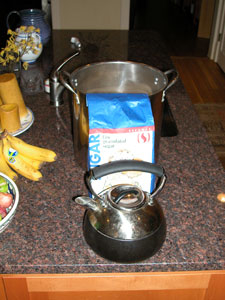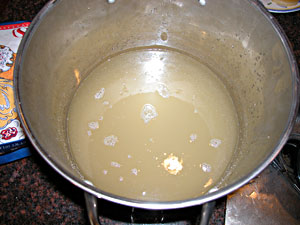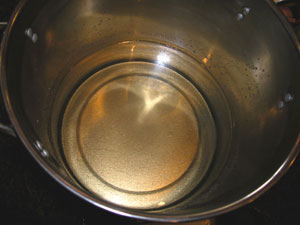 One pot, one kettle, and one ten pound bag of sugar equals a late autumn meal for one hive of bees. As the year winds down, beekeepers who want to ensure that the honeybees have enough stores for the winter mix 2 parts granulated cane sugar to one part hot water in order to make a heavy, honey-like syrup for the bees to sock away in the dwindling days left. The heavier syrup is supposed to signal to the queen that she should stop laying (if she hasn't already: some beekeepers around here say that in our climate she always lays a little through the winter) and the girls should get ready to cluster up and stay warm. By now, the drones are all gone, and things have become serious.
One pot, one kettle, and one ten pound bag of sugar equals a late autumn meal for one hive of bees. As the year winds down, beekeepers who want to ensure that the honeybees have enough stores for the winter mix 2 parts granulated cane sugar to one part hot water in order to make a heavy, honey-like syrup for the bees to sock away in the dwindling days left. The heavier syrup is supposed to signal to the queen that she should stop laying (if she hasn't already: some beekeepers around here say that in our climate she always lays a little through the winter) and the girls should get ready to cluster up and stay warm. By now, the drones are all gone, and things have become serious.I've gone out and hefted my hives, and the rundown is like this:
- The Carniolans in Wilde seem to be very heavy with stores, I can barely lift the back of the boxes. There is still a bit of mite drop;
- The mixed-but-mostly Carnie colony in Twain needs more food, but is not at great risk. Some deformed bees are showing up, leading me to believe that they may be into the stores that have some virus in them. Low mite drop;
- The Carniolan mill bees are kind of light and are still taking syrup. Worrisome mite situation;
- The Italians in the Doug colony at the Monastery are a little light, but doing well for mites. Taking feed slowly, as usual;
- The Carnies in MaryEllen are more vibrant, but could still use a bit more stores.
 When at loose ends, I make food for the girls. This photo shows what 10 pounds of sugar looks like in about 5 pints of water, just out of the kettle. It's cloudly, and must be stirred for a while. The water must be hot to make such a super-saturated solution, and I boil it before pouring. You must never heat the sugar directly on the burner, however, because the bees cannot digest carmelized sugar and can get potentially deadly dysentery in that manner.
When at loose ends, I make food for the girls. This photo shows what 10 pounds of sugar looks like in about 5 pints of water, just out of the kettle. It's cloudly, and must be stirred for a while. The water must be hot to make such a super-saturated solution, and I boil it before pouring. You must never heat the sugar directly on the burner, however, because the bees cannot digest carmelized sugar and can get potentially deadly dysentery in that manner. In just ten minutes or so, the mixture becomes crystal clear. It has to cool before you use it, and once it does you sometimes get little floes of sugar ice floating on the top. It helps that my counters are stone and this pot is a thin, cheap one, because I can move it around on the countertop to make it cool faster.
In just ten minutes or so, the mixture becomes crystal clear. It has to cool before you use it, and once it does you sometimes get little floes of sugar ice floating on the top. It helps that my counters are stone and this pot is a thin, cheap one, because I can move it around on the countertop to make it cool faster.This is about what I would give to one hive of bees in my usual hivetop feeder. The time it takes for the bees to eat it or store it varies with the temperament of the bees and the time of the year. Some hives don't seem to like to be fed, like Frances over at the monastery, or Wilde in the late autumn. I have a small ace in the hole stored in the basement, one medium with some half-filled combs, ready to be placed on top of a hive in need in February. These combs were pulled along with full ones during the honey harvest, one or two per hive riding along in honey supers that were mostly full. When I can no longer feed syrup, or if the girls refuse any candy frames they might get, at least I know that those may do the trick.
6 comments:
Thanks;
For My Blog's link.
Halil Bilen
Turkey
Really nice pictures. I'm feeding mine, too, but have been using 1:1 - I'll switch to 2:1 in about a week.
Linda T
I was looking for bee feeding tips and ran across this. Thanks for the info. (I'm actually trying to feed a wild hive whose tree we had to take down.)
I am no bee expert and live in the UK I have found a lone bumble bee on the path, it seems very weak. I have bought inside and it seems now to have recovered, what shall I do with it, where would I leave it outside as we are in winter, can you help?
One of the main differences between honeybees and almost every other kind of bee is their ability to winter over. Your poor bumblebee had reached the end of the road: they get a single summer, then the life of their family goes on in the form of a fertile queen who was hiding somewhere safe -- like under some bark, or in some loose soil. Most of the things that have made wintering possible for honeybees -- emerging as a large family in time to pollinate spring gardens, and storing honey, for instance! -- are key factors in their long relationship with us.
I have just been able to start keeping bees but have researched them for years. My cousins and uncle heve kept bees for over 40 some years. I will be using a fluffy fondant feeder on top of my hive starting this week. I've heard rave revues about northern bee keepers having great success using them to over winter hives. I made one and being the tinkerer that i am I put in some of my own design features. So far my bees have made it through the first cold snap and have been taking cleansing flights on days that are 45 & above which haven't been many. I will keep you posted on how they are doing after the last of the cold weather. We have had some really low temps the last couple of years that are actually below normal. Keep Em' Buzzin. Lyle
Post a Comment